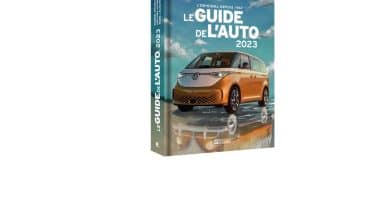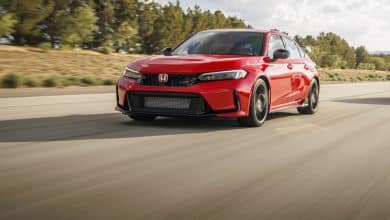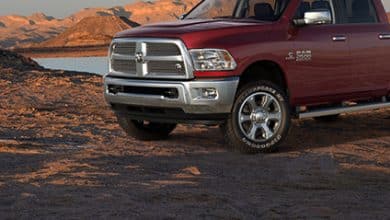Contents [hide]
Its design

PHOTO PROVIDED BY JLR
The 2024 Range Rover Sport PHEV
Only available in the Autobiography livery, the plug-in hybrid version of the SUV is dressed in its finest attire. The design is brimming with confidence, starting with the front frame topped with sinister-looking headlights. From the side, the taut lines reign for continuity and the 23-inch (!) wheels take care of filling the space freed up by the wheel arches. The retractable handles add a smooth look to the rendering and the glossy black beyond the beltline lightens the visuals in a nice way. The rear continues the refinement effort with thin lights that complement a black band. There is a very harmonious side and a desire for timelessness to this Range Rover Sport, which stands out from many more flashy SUVs.
On board

PHOTO PROVIDED BY JLR
The interior of the 2024 Range Rover Sport PHEV
The horizontality of the exterior design dictates the theme of the dashboard, which multiplies the rectangular references. Using less noble materials than the Range Rover, the SUV nevertheless displays luxury by means of finely assembled aromatic leathers. We perceive by touch a solidity of assembly worthy of the positioning and the price (more than $140,000) of the SUV. The only dissonant note: Land Rover is on the wrong track by choosing for 2024 to skip the physical buttons to incorporate them into the infotainment system. Taking advantage of a footprint similar to a BMW X5, the Range Rover Sport also benefits from a spacious interior complemented by numerous compartments.
Under the hood

PHOTO PROVIDED BY JLR
The 2024 Range Rover Sport PHEV
Essentially, this model is powered by a 160 kW electric motor and a 3.0-litre turbocharged inline-six. A 38.2 kWh battery provides a range of 90 km, if the route is not entirely made up of motorways. The electric mode suits this Range Rover Sport particularly well, but the slightly jerky calibration of the electric motor at low speeds exposes the need for further development. The hybrid mode unleashes the full power (542 horsepower) without too much theatrics. The initial thrust arrives after a slight delay and the six-cylinder is much more discreet than expressive. It's the kind of performance you'd expect, with aplomb that lowers the 0-100 km/h time under 5 seconds.
Behind the wheel

PHOTO PROVIDED BY JLR
The 2024 Range Rover Sport PHEV
Despite its name, this Range Rover Sport is much more in its element at moderate speeds. Its air suspension allowing variable ground clearance teams up with adaptive dampers to provide an exceptional ride. Its cornering grip is also astonishing, despite its weight and high center of gravity. Its steering is precise and just firm and communicative enough to tackle a series of curves without being tiresome on long journeys. The SUV also benefits from steerable rear wheels that make parking maneuvers easier. We can't ignore the off-road gear guided by the Terrain Response system, which offers a multitude of configurations, depending on the type of ground.
Embedded technologies

PHOTO PROVIDED BY JLR
The multimedia screen appears to float on the dashboard, an original presentation, but the absence of buttons complicates handling.
This Range Rover Sport is equipped with the latest generation of Land Rover's multimedia system called Pivi Pro. It is based on a 13.1-inch touchscreen that floats in the center of the dashboard. The interface is intuitive thanks to the use of vertical tabs on both sides of the screen. The system is also rather fast and responsive to touch manipulations. However, we regret the absence of physical controls for the many driving modes. There is also no volume adjustment wheel, except on the steering wheel. Moreover, the digital instrument screen displays excellent definition and is configurable as desired, but requires some time to adapt to the buttons placed on the steering wheel.
The verdict

PHOTO PROVIDED BY JLR
The 2024 Range Rover Sport PHEV
The Range Rover Sport plug-in hybrid is not a revolutionary product in itself. The SUV instead relies on a convincing powertrain to enhance its road qualities. With an electric range of almost 100 km, it generally operates without fuel, reinforcing the serenity of its driving experience. The asking price is high, but it is a luxury product that gives an impression of completion and refinement. Not everything is perfect, starting with the disappearance of physical buttons, reliability to be proven and some adjustments to the electric motor. We can nevertheless say that this version makes this model truly persuasive… while waiting for an electric variant promised this year.
Notebook
Built-in fast charging
Unlike many plug-in hybrid models, this Range Rover Sport is compatible with rapid charging, which can provide up to 50 kW of power. On a domestic charging station, the system limited the power to 7.4 kW during the week of testing.
A remarkable audio chain
The 29-speaker Meridian Signature system that comes standard in this trim does an admirable job of drawing out sonic nuances with power.
Off-road driving modes
The Terrain Response system features five profiles based on the surface encountered, plus an automated mode. An off-road cruise control controls the pace and keeps the vehicle on the trail by constantly evaluating body movements.
A fairly aerodynamic body
Despite its decidedly SUV-like silhouette, the Range Rover Sport has a drag coefficient equal to that of a Nissan Ariya (0.29 cx) to support its electric autonomy.
It can tow too
The plug-in hybrid version can tow a load of up to 3,000 kg (6,614 lb), adding another element to its great versatility.
Technical sheet
- Test version: Range Rover Sport P550e PHEV Autobiography
- Price (with options, freight and preparation): $162,285 (starting price of $141,500)
- Engine: 3.0L L6 DOHC Turbocharged + Electric Motor
- Power: 543 hp from 5500 to 6500 rpm
- Torque: 590 lb-ft from 2000 to 5000 rpm
- Transmission: Eight-speed automatic with manual mode
- Powertrain architecture: longitudinal front engine, all-wheel drive
- Electric autonomy (manufacturer): 82 km
- Competitors (plug-in hybrids): BMW X5, Mercedes-Benz GLE, Porsche Cayenne and Volvo XC90
- What's new in 2024? Revised plug-in hybrid version with more power and range












